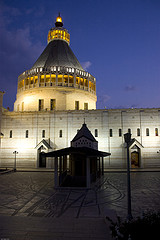Magnificat

Basilica of the Annunciation, Nazareth
If you wander through the modern town of Nazareth, through the Old City and Latin Quarter, up the long winding street called Al-Bishara, past the modern Israeli markets selling cheap clothes, electrical goods and huge, exotic fruits and vegetables, you will eventually find yourself standing outside the Church of the Annunciation. Built in 1966 with a dome that, when viewed from the inside, is like looking directly into the wide-open bloom of a vast, white lily, this church covers the site of the maiden home of Mary, mother of Christ – the site of the visitation by the Archangel Gabriel to announce the forthcoming divine motherhood of the virgin, and unmarried, Mary. This visitation is recorded by St Luke (Chapter 1, vv 26-38), the only one of the four canonical evangelists to mention it. If you enter the church you can walk down into a lower sanctuary where, covered by a baldacchino, there are the remains of a lowly, cave-like dwelling. Visible is a main room with uneven stone walls and floor and, at the back, a small, narrow flight of ancient worn stone steps leading to a single upper chamber. A tall white candle burns perpetually in the lower room. This room, possibly the living quarters of the Holy family and the place where we can imagine Jesus Christ having spent at least some of his childhood, is a place of pilgrimage for many Christians throughout the world.
The words of the Magnificat, prompted by the visitation of Gabriel to this lowly dwelling and uttered by the humbled Mary as a canticle of praise and devotion, in the house of Elizabeth, mother of St John the Baptist (St Luke, Chapter 1, vv 46-55), have remained a central and frequently used text within the Christian church. The sentiment of the Magnificat first appears in the bible, somewhat prophetically, in the old testament as ‘the Song of Hannah’ (1. Samuel, Chapter 2, vv 1-10).
Along with the Ordinary of the Mass, the Magnificat was the most prolifically set liturgical text, polyphonically, from the mid fifteenth century onwards. Like the Mass, this was a result of the demand placed on composers for settings of the Magnificat created by liturgical practice, as the Magnificat was, and still is, a central part of the daily office of Vespers or Evening Prayer in the Catholic and Protestant churches of western Europe, and was sung polyphonically on Sundays and feast days. In the eastern Orthodox Church the text is found in the book of Odes, a book of the bible found only in the Orthodox Church, where it is sung at Sunday Mattins. After the English Reformation, the text survived the Anglican split from Rome and was included as the first of two biblical canticles in the office of Evening Prayer (Evensong) by Archbishop Thomas Cranmer in his original Book of Common Prayer of 1549. It survived rewrites of that book in 1552, and again in 1662, following the English civil war (the 1662 version was to become the definitive prayer book for the Anglican communion for over two hundred and sixty years – until its next revision in 1928). The Magnificat remains in daily use, at Evening Prayer, in churches and cathedrals throughout the world, both Catholic and Protestant.
The text of the verses from St Luke are as follows (the Gloria Patri is not included in the gospel but is sung when the text is used liturgically as a canticle):
vv |
LATIN |
ENGLISH |
46 |
Magnificat anima mea Dominum. |
My soul doth magnify the Lord. |
47 |
Et exultavit spiritus meus in Deo salutari meo. |
And my spirit hath rejoiced in God my Saviour. |
48 |
Quia respexit humilitatem ancillae suae; ecce enim ex hoc beatam me dicent omnes generationes. |
For He hath regarded the low estate of His handmaiden; for, behold, from henceforth I shall be called blessed by all generations |
49 |
Quia fecit mihi magna qui potens est; et sanctum nomen ejus. |
For He that is mighty hath done great things to me; and holy is His name. |
50 |
Et misericordia a progenie in progenies timentibus eum. |
And His mercy is on them that fear Him fromgeneration to generation. |
51 |
Fecit potentiam in bracchio suo; Dispersit superbos mente cordis sui. |
He hath shewed strength with His arm; He hath scattered the proud in the imagination of their hearts. |
52 |
Deposuit potentes de sede et exultavit humiles. |
He hath put down the mighty from their seats and exalted them of low degree. |
53 |
Esurientes implevit bonis; et divites dimisit in anes. |
He hath filled the hungry with good things; and the rich He hath sent empty away. |
54 |
Suscepit Israel puerum suum recordatus misericordiae suae. |
He hath holpen His servant Israel in remembrance of His mercy. |
55 |
Sicut locutus est ad patres nostros, Abraham, et semini ejus in secula. |
As He spake to our fathers, to Abraham, and to his seed for ever. |
Gloria Patri et Filio et Spiritui Sancto. |
Glory be to the Father, and to the Son and to the Holy Ghost. |
|
Sicut erat in principio, et nunc et semper. Et in secula seculorum. Amen |
As it was in the beginning, is now, and ever shall be. World without end. Amen. |
Translation from the Authorised King James Bible.
All of the Magnificats in this evening’s concert will be sung in Latin, as originally intended by their composers.
Notes by Peter Parfitt ©Aberdeen Bach Choir 2010